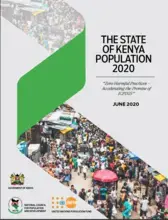It is estimated that the global population will reach 8 billion in November. This milestone is a moment for celebration on today’s world population day, as it indicates the incredible advancements made in health care, poverty reduction, and social development. Infant and maternal mortality have declined, and people are living longer and healthier lives. Kenya’s population stands at 50 million strong, with the youth under 35 making up 76% of this number. With a fertility rate of 3.4 children per woman, Kenya’s population is bound to keep growing, while remaining youthful.
Adolescents in Kenya are faced with the triple threat of rising new HIV infections, pregnancy and gender-based violence. In 2020 adolescents aged 10-19 years contributed 15 percent of all new HIV infections. In 2021, approximately 317,644 pregnancies were reported among adolescents who sought ante-natal care in various health facilities across the country.
As we prepare to observe the milestone of 8 billion people, we must remember that the value of humanity is not divided as we add to its membership, nor does it diminish with population decline. Our focus should firmly remain on becoming demographic resilient by investing in education, health, gender equality and access to decent work for all citizens. For Kenya’s population of young people, the future is shaped by a complex and interconnected set of social, cultural, economic, environmental and political factors. Already, a high proportion of adolescents and young people are not in education, employment or training. In particular, adolescents in Kenya are faced with the triple threat of rising new HIV infections, pregnancy and gender-based violence. In 2020 adolescents aged 10-19 years contributed 15 percent of all new HIV infections.
In 2021, approximately 317,644 pregnancies were reported among adolescents who sought ante-natal care in various health facilities across the country. These numbers speak to the findings of recent research by UNFPA which reveals that nearly a third of all women in developing countries begin childbearing at age 19 and younger, and nearly half of first births to adolescents are to girls aged 17 and younger. Complications from giving birth are a leading cause of death and injury for adolescent girls, but being an adolescent mother can also lead to other grave violations of their human rights and serious social consequences, including child marriage, intimate-partner violence and mental health issues.
The Triple Threat of HIV infections, gender-based violence and pregnancy among adolescents deeply curtails young people’s fundamental rights to quality life, access to education and
healthcare leading to lifelong physical, mental and socio-economic problems. Evidence shows that when you invest in young people, the return on society is immeasurable. Teenage pregnancy for example, should not mean an end to a girl’s education. Take for example the case of 16-year-old Kibera resident Winnie, who at the height of the Covid-19 pandemic found herself out of school and with no means to acquire basic necessities such as food and sanitary towels. After an older man promised to help, Winnie found herself pregnant and with no support. She turned to a community-based organization working in Kibera supported by UNFPA, which provided her with personal mentorship and guided her return to school. Now, she is working towards her dream of becoming a broadcaster and telling stories from her community, Kibera.
Winnie’s story demonstrates that collaborative solutions are key to addressing common challenges facing Kenya’s youth population today. Working together, stakeholders can come up with comprehensive, holistic policy responses that are based on evidence and allow young people to exercise their full range of rights, including reproductive rights.
Shifting our focus from “population” to “people” also calls for a re-examining of harmful gender and social norms, especially related to the roles of women in families and societies. Women and girls continue to face inequalities and vulnerabilities which are made worse by climate- related emergencies such as the ongoing drought. Such crises cause significant barriers in accessing services such as maternal health care, and life-saving medicines including contraception. Evidence has shown that gender-based violence and harmful practices, including child marriage and female genital mutilation, also increase among climate-affected populations. We must get smart about climate mitigation strategies and policies to build resilient communities and protect the rights of women and girls, particularly their reproductive choices and their right to live free from violence.
No matter the direction of population growth, every individual deserves to benefit from a more just, prosperous and sustainable Kenya. Only then can we tackle challenges facing the country and forge a world where health, dignity, and education are rights and realities.
This article was originally published in The Standard Newspaper, on 11th July, 2022.



